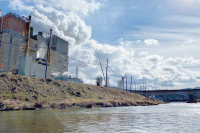Conversation – what conversation?
Regular readers of this column probably already know that I’ve run afoul of many regional environmental groups by questioning the environmental and ecological cost-benefits of placing industrial-scale wind farms on top of the mountain ridges across the Appalachians.
In a response to my July 22 Naturalist’s Corner “Up in the air” regarding the rumblings in Raleigh over senate bill 1068 which would, if passed, essentially pave the way for industrial wind farms in certain areas across Western North Carolina, my friend Avram Friedman, executive director of the Canary Coalition, states, “I’m glad he’s started the conversation again.”
Well that’s one of the problems — there’s been very little conversation. Sure, environmental and conservation organizations have come together and there have been some pro-wind seminars at Appalachian State University and there have been some public hearings in certain counties that have endeavored to enact wind-power ordinances, but there has been very little large scale public vetting about an industry that all of us will be subsidizing and that will impact the natural resources across the region.
I tried to initiate a dialogue via Smoky Mountain News — both print and online — back last spring, but it fell on deaf ears. But perhaps now, with the General Assembly embroiled, enough interest will be piqued that newspapers and organizations across the state will investigate more fully and generate more public involvement. And I certainly join with Avram in encouraging that conversation — the kind of conversation that would help those as “wind-challenged” as I to get a clearer picture of the benefits of industrial wind production.
Avram states in his response, “... But, by combining measures designed to reduce energy consumption with an aggressive program to develop wind in the west (which is the least expensive option of producing energy), we can avoid completing Cliffside and even begin phasing out some of the other old coal plants in North Carolina.”
Now I’m no advocate of Cliffside or any other coal plant in North Carolina. But if I read Western North Carolina Renewable Energy Initiative’s “NC Wind Power Facts” correctly, the areas of Western North Carolina identified by Senate bill 1068 as suitable for wind production after all exclusions, setbacks, etc., could produce 768 megawatts (MW) of electricity annually — about 2 percent of the state’s current output. I don’t know how long it would take to develop those suitable sites, but I’m sure build out would take longer than a year or two and according to the North Carolina Utilities Commission, electricity consumption will grow by 2 percent or so each year for the next five years. The math just doesn’t add up.
Related Items
And you could replace every tree in Western North Carolina with a wind turbine, but unless you point them all westward and turn ‘em on so that they blow back all the ozone produced from western coal-fired plants they will have very little impact on the haze and ozone we experience here, in the mountains.
Avram also states that developing the wind resources of Western North Carolina would create, “... thousands of green jobs ...” Yet, NC Wind Power Facts says that 350 new long-term jobs would be created.
Let’s have those conversations. Let’s air it all out so everyone understands. When Avram speaks of 1,000 megawatts of readily available power and/or Wind Power Facts talks about 768 Mws, are they talking about “rated capacity” or “capacity factor?” There’s quite a difference.
Don Hendershot can be reached at This email address is being protected from spambots. You need JavaScript enabled to view it.









